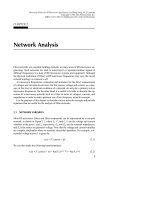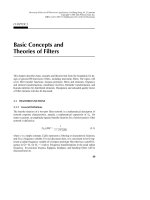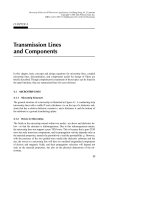Tài liệu Lò vi sóng RF và hệ thống không dây P1 docx
Bạn đang xem bản rút gọn của tài liệu. Xem và tải ngay bản đầy đủ của tài liệu tại đây (144.53 KB, 9 trang )
CHAPTER ONE
Introduction
1.1 BRIEF HISTORY OF RF AND MICROWAVE WIRELESS SYSTEMS
The wireless era was started by two European scientists, James Clerk Maxwell and
Heinrich Rudolf Hertz. In 1864, Maxwell presented Maxwell's equations by
unifying the works of Lorentz, Faraday, Ampere, and Gauss. He predicted the
propagation of electromagnetic waves in free space at the speed of light. He
postulated that light was an electromagnetic phenomenon of a particular wavelength
and predicted that radiation would occur at other wavelengths as well. His theory
was not well accepted until 20 years later, after Hertz validated the electromagnetic
wave (wireless) propagation. Hertz demonstrated radio frequency (RF) generation,
propagation, and reception in the laboratory. His radio system experiment consisted
of an end-loaded dipole transmitter and a resonant square-loop antenna receiver
operating at a wavelength of 4 m. For this work, Hertz is known as the father of
radio, and frequency is described in units of hertz (Hz).
Hertz's work remained a laboratory curiosity for almost two decades, until a
young Italian, Guglielmo Marconi, envisioned a method for transmitting and
receiving information. Marconi commercialized the use of electromagnetic wave
propagation for wireless communications and allowed the transfer of information
from one continent to another without a physical connection. The telegraph became
the means of fast communications. Distress signals from the S.S. Titanic made a
great impression on the public regarding the usefulness of wireless communications.
Marconi's wireless communications using the telegraph meant that a ship was no
longer isolated in the open seas and could have continuous contact to report its
positions. Marconi's efforts earned him the Nobel Prize in 1909.
In the early 1900s, most wireless transmission occurred at very long wavelengths.
Transmitters consisted of Alexanderson alternators, Poulsen arcs, and spark gaps.
Receivers used coherers, Fleming valves, and DeForest audions. With the advent of
DeForest's triode vacuum tube in 1907, continuous waves (CW) replaced spark gaps,
1
RF and Microwave Wireless Systems. Kai Chang
Copyright # 2000 John Wiley & Sons, Inc.
ISBNs: 0-471-35199-7 (Hardback); 0-471-22432-4 (Electronic)
and more reliable frequency and power output were obtained for radio broadcasting
at frequencies below 1.5 MHz. In the 1920s, the one-way broadcast was made to
police cars in Detroit. Then the use of radio waves for wireless broadcasting,
communications between mobile and land stations, public safety systems, maritime
mobile services, and land transportation systems was drastically increased. During
World War II, radio communications became indispensable for military use in
battle®elds and troop maneuvering.
World War II also created an urgent need for radar (standing for radio detection
and ranging). The acronym radar has since become a common term describing the
use of re¯ections from objects to detect and determine the distance to and relative
speed of a target. A radar's resolution (i.e., the minimum object size that can be
detected) is proportional to wavelength. Therefore, shorter wavelengths or higher
frequencies (i.e., microwave frequencies and above) are required to detect smaller
objects such as ®ghter aircraft.
Wireless communications using telegraphs, broadcasting, telephones, and point-
to-point radio links were available before World War II. The widespread use of these
communication methods was accelerated during and after the war. For long-distance
wireless communications, relay systems or tropospheric scattering were used. In
1959, J. R. Pierce and R. Kompfner envisioned transoceanic communications by
satellites. This opened an era of global communications using satellites. The satellite
uses a broadband high-frequency system that can simultaneously support thousands
of telephone users, tens or hundreds of TV channels, and many data links. The
operating frequencies are in the gigahertz range. After 1980, cordless phones and
FIGURE 1.1 Summary of the history of wireless systems.
2
INTRODUCTION
cellular phones became popular and have enjoyed very rapid growth in the past two
decades. Today, personal communication systems (PCSs) operating at higher
frequencies with wider bandwidths are emerging with a combination of various
services such as voice mail, email, video, messaging, data, and computer on-line
services. The direct link between satellites and personal communication systems can
provide voice, video, or data communications anywhere in the world, even in the
most remote regions of the globe.
In addition to communication and radar applications, wireless technologies have
many other applications. In the 1990s, the use of wireless RF and microwave
technologies for motor vehicle and highway applications has increased, especially in
Europe and Japan. The direct broadcast satellite (DBS) systems have offered an
alternative to cable television, and the end of the Cold War has made many military
technologies available to civilian applications. The global positioning systems
(GPSs), RF identi®cation (RFID) systems, and remote sensing and surveillance
systems have also found many commercial applications.
Figure 1.1 summarizes the history of these wireless systems.
1.2 FREQUENCY SPECTRUMS
Radio frequencies, microwaves, and millimeter waves occupy the region of the
electromagnetic spectrum below 300 GHz. The microwave frequency spectrum is
from 300 MHz to 30 GHz with a corresponding wavelength from 100 cm to 1 cm.
Below the microwave spectrum is the RF spectrum and above is the millimeter-wave
spectrum. Above the millimeter-wave spectrum are submillimeter-wave, infrared,
and optical spectrums. Millimeter waves (30±300 GHz), which derive their name
from the dimensions of the wavelengths (from 10 to 1 mm), can be classi®ed as
microwaves since millimeter-wave technology is quite similar to that of microwaves.
Figure 1.2 shows the electromagnetic spectrum. For convenience, microwave and
millimeter-wave spectrums are further divided into many frequency bands. Figure
1.2 shows some microwave bands, and Table 1.1 shows some millimeter-wave
bands. The RF spectrum is not well de®ned. One can consider the frequency
spectrum below 300 MHz as the RF spectrum. But frequently, literatures use the RF
term up to 2 GHz or even higher.
The Federal Communications Commission (FCC) allocates frequency ranges and
speci®cations for different applications in the United States, including televisions,
radios, satellite communications, cellular phones, police radar, burglar alarms, and
navigation beacons. The performance of each application is strongly affected by the
atmospheric absorption. The absorption curves are shown in Fig. 1.3. For example, a
secure local area network would be ideal at 60 GHz due to the high attenuation
caused by the O
2
resonance.
As more applications spring up, overcrowding and interference at lower
frequency bands pushes applications toward higher operating frequencies. Higher
frequency operation has several advantages, including:
1.2 FREQUENCY SPECTRUMS
3
FIGURE 1.2 Electromagnetic spectrum.
4
INTRODUCTION
1. Larger instantaneous bandwidth for greater transfer of information
2. Higher resolution for radar, bigger doppler shift for CW radar, and more
detailed imaging and sensing
3. Reduced dimensions for antennas and other components
4. Less interference from nearby applications
5. Fast speed for digital system signal processing and data transmission
6. Less crowded spectrum
7. Dif®culty in jamming (military applications)
TABLE 1.1 Millimeter-Wave Band Designation
Frequency Range
Designation (GHz)
Q-band 33±50
U-band 40±60
V -band 50±75
E-band 60±90
W -band 75±110
D-band 110±170
G-band 140±220
Y -band 220±325
FIGURE 1.3 Absorption by the atmosphere in clear weather.
1.2 FREQUENCY SPECTRUMS
5









